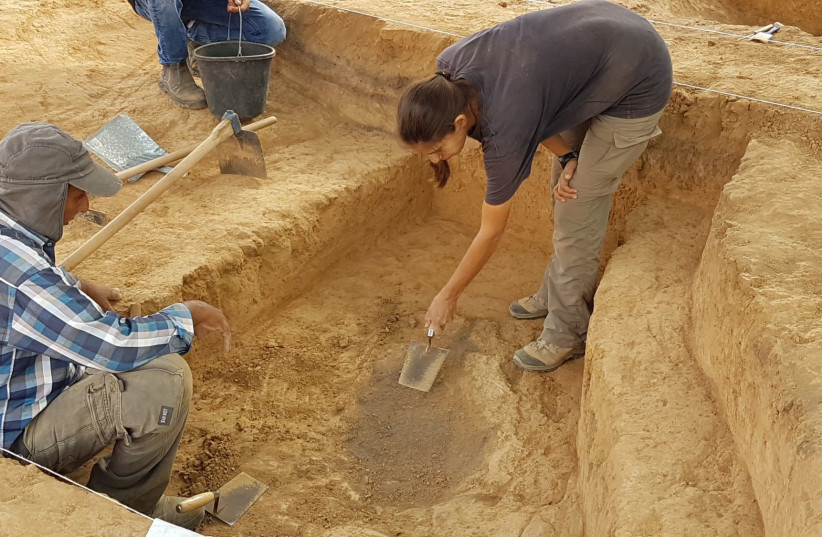 6,500-year-old ‘furnace’ discovered in Beersheba
6,500-year-old ‘furnace’ discovered in Beersheba
HANNAH BROWN
“It’s important to understand that the refining of copper was the high tech of that period.”

Beersheba may have been the true birthplace of Start Up Nation, since according to a new study by Tel Aviv University and the Israel Antiquities Authority, the capital of the Negev could have been the home of the world’s first furnace 6,500 years ago.
The results of the study have just been published in the prestigious Journal of Archaeological Science.
It details how a 6,500-year-old workshop for smelting copper ore once operated in the Neveh Noy neighborhood of Beersheba.
This study sheds light both on the level of technical advancement in that era and region and the hierarchy in the society, giving evidence for a theory that there was a clearly defined elite that possessed expertise and knew professional secrets, which preserved its power, because its members were the only ones who knew how to create shiny copper.
The study, which was conducted over several years, began in 2017 in the capital of the Negev when the workshop was first uncovered during an Israel Antiquities Authority emergency archaeological excavation to safeguard antiquities.
The study was conducted by Prof. Erez Ben-Yosef, Dana Ackerfeld and Omri Yagel of the Jacob M. Alkow Department of Archeology and Ancient Near Eastern Civilizations at Tel Aviv University, in conjunction with Dr. Yael Abadi-Reiss, Talia Abulafia, and Dmitry Yegorov of the Israel Antiquities Authority and Dr. Yehudit Harlavan of the Geological Survey of Israel.
According to Abulafia, director of the excavation on behalf of the Israel Antiquities Authority, “The excavation revealed evidence for domestic production from the Chalcolithic period, about 6,500 years ago. The surprising finds include a small workshop for smelting copper with shards of a furnace – a small installation made of tin in which copper ore was smelted – as well as a lot of copper slag.”

The Chalcolithic period (the word “chalcolithic” is made up of the Greek words for “copper” and “stone”) got this name because although metalworking was already in evidence, the tools used were still made of stone. An analysis of the isotopes of ore remnants in the furnace shards show that the raw ore was brought to Neveh Noy neighborhood from Wadi Faynan, located in present-day Jordan, more than 100 km. from Beersheba.
During the Chalcolithic period, when copper was first refined, the process took place far from the mines, unlike the prevalent historical model in which furnaces were built near the mines for both practical and economic reasons. Researchers theorize that the copper was refined so far from the mines to preserve the technological secret.
“It’s important to understand that the refining of copper was the high tech of that period. There was no technology more sophisticated than that in the whole of the ancient world,” Erez Ben-Yosef said. “Tossing lumps of ore into a fire will get you nowhere. You need certain knowledge for building special furnaces that can reach very high temperatures while maintaining low levels of oxygen.”
The study provides new evidence on the extent to which this society, which was not yet urbanized, was hierarchical. The scientists feel that the findings from Neveh Noy could show that the elite who knew how to use the technology held a privileged position. The copper objects were not made to be used, but rather served some ritual purpose and had a symbolic value. They were probably used in rituals while the everyday objects in use continued to be of stone.
Ben-Yosef said that the archaeology of the land of Israel shows evidence of the influence of the Ghassulian culture, named for the archaeological site in Jordan, Tulaylât al-Ghassûl, where the culture was first recognized. This culture, which spanned the region from the Beersheba Valley to present-day southern Lebanon, was unusual for its artistic achievements and ritual objects, as evidenced by the copper objects discovered at Nahal Mishmar and now on display at the Israel Museum in Jerusalem.
According to Ben-Yosef, the people who lived in the area of the copper mines traded with members of the Ghassulian culture from Beersheba and sold them the ore, but they were incapable of creating the shiny refined copper objects. Even among the Ghassulian settlements along Wadi Beersheba, copper was refined by experts in special workshops.
A chemical analysis of remnants indicates that every workshop had its own special formula which it did not share with its competitors. He said that it would seem that, in that period, Wadi Beersheba was filled with water year-round, making the location convenient for smelting copper where the furnaces and other apparatus were made of clay.
“At the first stage of humankind’s copper production, crucibles rather than furnaces were used,” Ben-Yosef explained. “This small pottery vessel, which looks like a flower pot, is made of clay. It was a type of charcoal-based mobile furnace. Here, at the Neveh Noy workshop that the Israel Antiquities Authority uncovered, we show that the technology was based on real furnaces.
“This provides very early evidence for the use of furnaces in metallurgy and it raises the possibility that the furnace was invented in this region. It’s also possible the furnace was invented elsewhere, directly from crucible-based metallurgy, because some scientists view early furnaces as no more than large crucibles buried in the ground,” Ben-Yosef added.
“The debate will only be settled by future discoveries, but there is no doubt that ancient Beersheba played an important role in advancing the global metal revolution and that in the fifth millennium BCE the city was a technological powerhouse for this whole region.”
Zawartość publikowanych artykułów i materiałów nie reprezentuje poglądów ani opinii Reunion’68,
ani też webmastera Blogu Reunion’68, chyba ze jest to wyraźnie zaznaczone.
Twoje uwagi, linki, własne artykuły lub wiadomości prześlij na adres:
webmaster@reunion68.com
